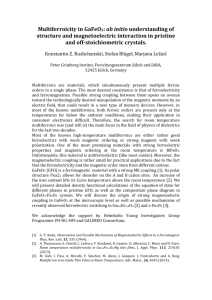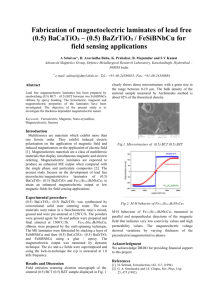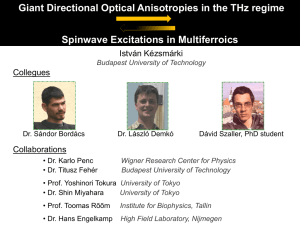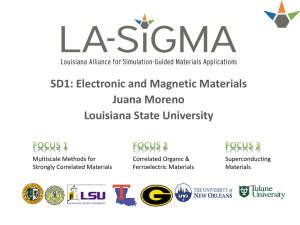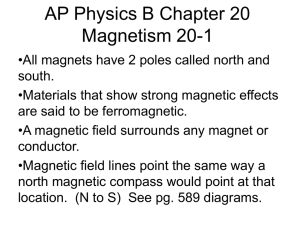Magnetoelectric Effect - Strongly Correlated Systems
advertisement
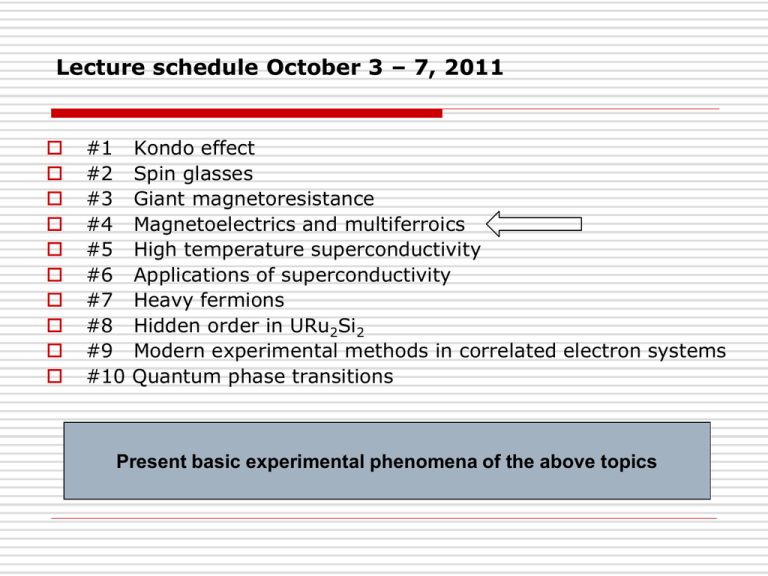
Lecture schedule October 3 – 7, 2011
#1
#2
#3
#4
#5
#6
#7
#8
#9
#10
Kondo effect
Spin glasses
Giant magnetoresistance
Magnetoelectrics and multiferroics
High temperature superconductivity
Applications of superconductivity
Heavy fermions
Hidden order in URu2Si2
Modern experimental methods in correlated electron systems
Quantum phase transitions
Present basic experimental phenomena of the above topics
Ferroelectrics to Magnetoelectrics&Multiferroics
Ferroelectrics (Valasek,1920’s): Spontaneous
electric polarization (P), e.g., BaTiO3
(displacive) & NaNO2 (order – disorder).
Proper FE: P as OP drives structural phase
transition at TC ; C-W law of dielectric constant
ε(T).
Improper FE: P is by-product of of another
structural phase transition with different OP.
Ferroelectricity in charge ordered systems
Cheong & Mostovoy, NM(2007)
Site-centered/bond-centered
Charge transfer
Exchange striction
Charge & spin ↑↑↓↓ order
Magnetoelectrics and Multiferroics
• Field Description: E P, H M; σ ε
• Recent(1990’s)resurgence of interest{exp.&theo.}
• Magnetoelectrics (late 1950’s-theory; early
1960’s-experiment)
• Multiferroic Materials (Cologne work)
• Fundamental Physics of Multiferroics
• Fundamental Physics vs. Applied Physics
• Engineering Devices
Idea of the Magnetoelectric Effect
Electric field
Mechanical
stress
Magnetric
field
Idea of the Magnetoelectric Effect
Polarization
Mech.
Strain
Magnetization
Idea of the Magnetoelectric Effect
Idea of the Magnetoelectric Effect
Magnetoelectric
Effect
Magnetoelectric Effect: Historical Survey
Theoretical driven, then experimentally observed
1894 — First discussion of an intrinsic correlation between magnetic and electric properties
P. Curie, J. de Physique (3rd Series) 3, 393 (1894)
"Les conditions de symétrie nos permettons d'imaginer qu'un corps à molécule dissymétrique se polarise peutêtre magnétiquement lorsqu'on le place dans un champ électrique.
1926 — Introduction of the term "magnetoelectric" for these correlations
P. Debye, Z. Phys. 36, 300 (1926)
Title: Bemerkung zu einigen neuen Versuchen über einen magneto-elektrischen Richteffekt
1957 — Magnetoelectric effect only in time-asymmetric (i.e. magnetically ordered) media!
L. D. Landau and E. M. Lifshitz, Electrodynamics of Continuous Media (Pergamon, Oxford, 1960)
"The magnetoelectric effect is odd with respect to time reversal and vanishes in materials
without magnetic structure"
1959 — Magnetoelectric effect predicted for antiferromagnetic Cr2O3
I. E. Dzyaloshinskii, J. Exptl. Teor. Fiz. 37, 881 (1959); Sov. Phys.—JETP 10, 628 (1959)
"We should like to show here that among the well known antiferromagnetic substances there is one,
namely Cr2O3, where the magnetoelectric effect should occur from symmetry considerations."
1960/61 — First observation in Cr2O3
E M:
H P:
D. N. Astrov, J. Exptl. Teor. Fiz. 38, 984 (1960); Sov. Phys.—JETP 11, 708 (1960)
V. J. Folen, G. T. Rado, and E. W. Stalder, Phys. Rev. Lett. 6, 607 (1961)
Magnetoelectric Effect: Historical Survey
"C'est la
dissymmétri
e
qui crée le
phénomène
"
1960:
M aE
Cr2O3
D.N. Astrov,
JETP 11, 708 (1960)
V.J. Folen,
1961:
P a*H
PRL 6, 607
(1961)
(P. Curie, 1894)
160
140
Publications / year
1960:
Theoretically not well understood
Small effect (10-5)
Limited choice of compounds
120
100
80
60
40
20
2000:
New theoretical concepts
"Giant" effects: induction of phase transitions
New materials: "magnetoelectricity on design"
0
1985
1990
1995
Year
2000
2005
Review:
J. Phys. D 38, R123 (2005)
Generating Large Magnetoelectric Effects
Limitation of the magnetoelectric effect:
Cannot be larger than the geometric mean of electric and magnetic
permeability
[W. F. Brown, R. M. Hornreich, S. Shtrikman, Phys. Rev. 168, 574 (1968)]
aij2 < ciie cjjm
Large magnetoelectric effects:
In ferroelectric samples
In ferromagnetic samples
Largest: in ferroelectric ferromagnetics
Do ferroelectric ferromagnetics exist?
Yes!! They are called multiferroics!
What is a “Multiferroic”?
“Crystals can be defined as multiferroic when two or more of the
xprimary ferroic properties are united in the same phase.”
Hans Schmid (University of Geneva, Switzerland)
in: M. Fiebig et al. (ed.), Magnetoelectric Interaction
Phenomena in Crystals, (Kluwer, Dordrecht, 2004)
Primary ferroic formation of switchable domains:
Excludes anti-ferroic
forms of ordering
Ferromagnetism
spontaneous
magnetization
Ferrotoroidicity
spontaneous
magnetic vortex
N S
Ferroelectricity
spontaneous
polarization
Ferroelasticity
spontaneous
strain
+ - + + - + -
Extension to anti-ferroic forms of ordering:
Compounds consisting of multiferroic sublattices (one or more of) whose primary
ferroic properties cancel in the macroscopic crystal
What is a Composite Multiferroic?
Constituent 1:
Piezoelectric
Constituent 2:
Magnetostrictive
Composite
Pseudo-magnetoelectric
BaTiO3
PbZr1-xTixO3 (PZT)
Ba0.8Pb0.2TiO3
Bi4Ti3O12
PVDF
PbMg1/3V2/3O3 ...
CoFe2O4
Tb1-xDyxFe2
(= Terfenol-D)
LiFe5O8
YIG
Permendur
End compounds are not
magnetoelectric!
layered
Magnetoelectric effect is
a product effect!
...
particulate
piezoelectric
1
2: magnetostrictive
2
1:
Magnetic field magnetostrictive deformation
Transfer of deformation constituent 2 constituent 1
Deformation via piezoelectric effect voltage
First Composite Magnetoelectric Effect
Result:
Value of the magnetoelectric
pseudo effect in BaTiO3/CoFe2O4:
dE/dH = 130 mV/cmOe
a = 720 pT/Vm-1
Compare to best
magnetoelectrics:
BaTiO3/CoFe2O4
single-phase
Cr2O3: a = 4.13 pT/Vm-1
TbPO4: a = 36.7 pT/Vm-1
No significant advances on this
initial result until the year 2000!
H0
H(w)
~10 kOe
~10 Oe
Measuring Magnetoelectric Response in Composites
0
0
0
Time
V(w)
Hmax,w
w = 100 Hz – 1 MHz
0
0
Time
0
Time
The composite ME
effect is an AC effect
Vmax,w
G. Srinivasan et al.,
Phys. Rev. B 67, 014418 (2003)
V =101...5 mV/cmOe
Linear response for
Hmax,w
small intervals only
Self-Assembled Nanocomposite Multiferroics
Ferromagnet
ic CoFe2O4
pillars
Ferroelectri
c BaTiO3
matrix
Ferroelectric properties
Ferromagnetic properties
SrTiO3
substrate
ME coupling and phase
control also observed !
H. Zheng et al., Science 303, 661 (2004)
Magnetoelectric Phase Control in Nanocomposites
Force microscopy on BiFeO3/CoFe2O4
Magnetic control by electric field
+
1 mm
Magnetic
+20 kOe
Magnetic
-20 kOe
Electric
8 V
ME coupling mediated by strain
Estimated:
(10 V/cmOe)-1
MFM before
MFM after
application of +12 V
Line scans of marked regions
F. Zavaliche et al., Nano Lett. 5, 1793 (2005)
Natural Single-Phase Multiferroics
Three natural crystals
Congolite
Fe3B7O13Cl
Hubnerite
MnWO4
See Cologne work
Chambersite
Mn3B7O13Cl
Ni3B7O13I – A Milestone of Multiferroics Research
E. Ascher, H. Schmid et al., J. Appl. Phys. 37, 1404 (1966)
Rotation of magnetization by 90° [110] [110]
Triggers reversal of ferroelectric polarization [001] [001]
First example of magnetoelectric cross-control
Ferroelectric Ferromagnets
Most promising for applications, but not many compounds exist because...
+ - + + - + -
Likes 3dn with n=0
N S
N.A. Hill, J. Phys. Chem. B 104, 6694 (2000)
Likes 3dn with n0
The existing ferroelectric ferroelectrics are usually anti-ferroic with only a weak
ferromagnetic or ferroelectric component:
TbMn2O5
Mn3B7O13I
O. Crottaz,
Ferroelectrics
204, 45 (1997)
N. Hur, Nature 429, 392 (2004)
The quest for strong ferroelectric ferromagnets at 300 K is still far from being solved!
Magnetic Control of Ferroelectricity in TbMnO3
Magnetically driven ferroelectricity
See Cologne
work
Magnetic field triggers a ferroelectric phase transition with
polarization rotation by 90°
T. Kimura et al., Nature 426, 55 (2003)
Magnetic Phase Control by Electric Field in HoMnO3
T. Lottermoser et al., Nature 430, 541 (2004)
Theory of Multiferroics in Magnetic Spirals
• (P,E) and (M,H) linear coupling when they vary both in space and
time: ∂E/∂r ≈ ∂H/∂t
• Seek non-linear coupling, e.g., inhomogeneous magnetic order: third
order coupling PM∂M, then magnetically induced electric polarization
• So must search for spiral magnetic order, e.g., TbMnO3 et al.
• Spiral states are characterized by two vectors: Q propagation vector
and e3 = e1 x e2 , spin rotation axis. Therefore for non-collinear magnets:
P ║ e3 x Q
Magnetic Tunability of Multiferroics
How to measure P and ε ? HW problems
Symmetry Breakings Required for Multiferroics
Magnetic order breaks time
reversal symmetry (TRS)
Displacements of O2- breaks
inversion symmetry (ISB)
Magnetic exchange interaction
(with order - TRSB) causes
displacement of Mn3+ - ISB
Cologne Work on Multiferroics – Pyroxenes (AMSi2O6)
Pyroxenes :NaFeSi2O6, LiFeSi2O6 and LiCrFe2Si6
natural mineral
(crystal aegirine)
Magnetic properties of NaFeSi2O6
Dielectric properties of NaFeSi2O6
How can you measure the electrical polarization ?
Anisotropy of Polarization Pb and Pc
Phase diagram of NaFeSi2O6
Magnetoelectrics and Multiferroics – The End
• Questions
• Comments
• Suggestions ?
• Future Ideas ?
Pyrocurrent measurements of MnWO7
Cologne Work – TbMnO3
Thermal Expansion and Magnetostriction
Thermal Conductivity and Thermal Expansion
GdMnO3 – Thermal Expansion and Magnetostriction
Ferroelectrics Multiferroics
